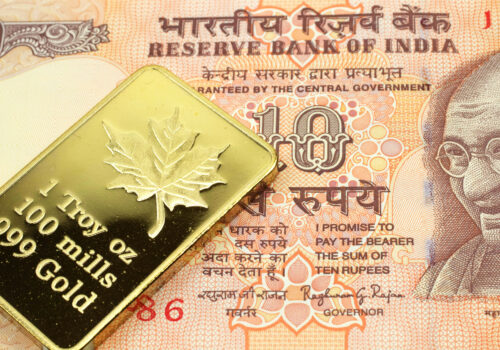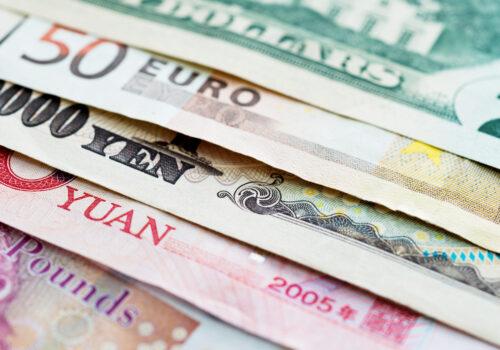Going for gold: Does the dollar’s declining share in global reserves matter?
Over the past twenty-three years, the US dollar (USD) has declined gradually as a share of global foreign exchange reserves, according to the International Monetary Fund (IMF). The shift has not benefited any other major currency viewed as a potential competitor to the USD, like the Euro, the Great British pound (GBP), or the yen. It has instead favored a group of lesser-used currencies, including the Canadian dollar, the Australian dollar, the Renminbi, the South Korean won, the Singaporean dollar, and the Nordic currencies. If gold—which has recently experienced a surge in purchases by many central banks, as well as the general public—is included in reserve asset portfolios, the share of the USD is smaller than what the IMF has highlighted. As geopolitical confrontations deepen, the share of the USD in global reserves is likely to continue declining in the future, eventually diminishing the dominant role of the dollar and the US in the international financial system.
The declining share of the USD in global reserves
The IMF conducts a regular survey of Currency Composition of Official Foreign Exchange Reserves (COFER). Its latest COFER report shows that in the first quarter of 2024, the share of USD sits at $6.77 trillion—54.8 percent of the total official foreign exchange (FX) reserves of $12.35 trillion, or 58.9 percent of allocated FX reserves where currency breakdowns having been reported to the IMF. This is a noticeable fall from the 71 percent share for USD in 2001. Basically, the decline in the USD share has been driven by efforts by central banks to diversify their reserves into a wider range of currencies—a move facilitated by improvements in financial markets and payment infrastructures in many countries. It is important to note that the share of USD would be lower if gold were included in global reserves.
Since the global financial crisis in 2008, the world’s central banks have increased their gold purchases in an attempt to manage heightened financial system uncertainty. Doing so has pushed gold prices up by 138 percent over the past sixteen years to reach the current record highs of over $2,600 per ounce. Gold buying has accelerated further in recent years as part of a growing popular demand. In 2022 and 2023, central banks purchased more than one thousand tons of gold per year, more than doubling the annual volume of the previous ten years. Purchases have been spearheaded by the central banks of China and Russia, followed by several emerging market countries including Turkey, India, Kazakhstan, Uzbekistan, and Thailand. In particular, the People’s Bank of China has raised the share of gold in its reserves from 1.8 percent in 2015 to a record 4.9 percent at present. At the same time, it has cut its holding of US Treasuries from $1.3 trillion in the early 2010s to $780 billion in June 2024.
Gold holdings, valued at market prices, account for 15 percent of global reserves. As a consequence, the share of the USD in total global reserves including gold would fall to 48.2 percent—instead of 54.8 percent of global foreign exchange reserves. The declining USD share suggests that while the USD is still the preferred currency most used by central banks for their reserves, it has been losing market share. It is not as dominant in the global reserves arrangement as it still is in trade invoicing, international financing, and FX transactions, according to the Atlantic Council’s Dollar Dominance Monitor.
Implications of the declining share of the USD in global reserves
Several reasons have been advanced to explain the growing demand for gold. For the general public, factors including hedging against inflation and/or against political and geopolitical risks, as well as positioning for expected US Federal Reserve rates cuts, appear reasonable. The central banks buying gold have also mentioned their desires to diversify their reserves portfolios, de-risking from vulnerability to sanctions risk from the United States and Europe. This sense of vulnerability has become acute for some countries in conflict or potential conflict with the US/Europe, after the West imposed substantial sanctions on Russia following its invasion of Ukraine. Decisions to immobilize overseas reserve assets of the Bank of Russia, subsequently appropriate the interest earnings of those assets, and threats to seize assets outright to help pay compensation to Ukraine proved especially unsettling.
In response, central banks have moved into gold in a way to diminish sanction risks. They can take physical possession of the gold they have bought and kept it in domestic vaults—instead of leaving it at Western financial institutions such as the US Federal Reserve, the Swiss National Bank, or the Bank for International Settlements, where gold is subject to Western jurisdiction. If the likelihood of geopolitical confrontation heightens, it follows that the declining trend in the share of the USD in global reserves will persist. This is consistent with the de-dollarization trend whereby a growing number of countries have developed ways to settle their cross-border trade and investment transactions in local currencies. Doing so chips away at the USD’s dominant role in the international payment system, as well as motivating countries to hold some reserves in each other’s currencies.
While the declining share of the USD in global reserves could continue to unfold gradually, as in the past two decades, central banks’ demand for USD for their reserves would eventually fall to a critical threshold. The US national saving rate is also likely to stay low and remain insufficient to cover domestic investment, leading to persistent US current account deficits. The combined effect of these trends in addition to falling foreign central bank demand for USD would constrain the US government’s ability to issue debt to finance its budgetary needs.
This constraint could become binding, a turning point heralded by sharp reductions in foreign official demand for US Treasuries. In that case, USD exchange rates would have to fall and interest rates to rise, simultaneously and in sufficient magnitude, to improve the risk-return prospects of US government debt and attract international investors. Any increase in US interest rates would be very problematic as interest payments on government debt have already become a burden, and are estimated to take up more than 20 percent of government revenue by 2025. They are threatening to crowd out other necessary public priorities including national defense, dealing with climate change, infrastructure, and human services. These developments would make the political fight over budgetary resources for competing needs even more antagonistic, and the important task of getting government deficits and debt under control more intractable. Both factors would ultimately put the US fiscal trajectory on an unsustainable path and threaten global financial stability—a risk not easily addressed given the deepening geopolitical contention.
Hung Tran is a nonresident senior fellow at the Atlantic Council GeoEconomics Center, a former executive managing director at the Institute of International Finance and former deputy director at the International Monetary Fund.

At the intersection of economics, finance, and foreign policy, the GeoEconomics Center is a translation hub with the goal of helping shape a better global economic future.
Further reading
Mon, Jun 17, 2024
India outpaces the rest of the G20 in gold purchases
Econographics By Josh Lipsky, Alisha Chhangani
In the last four months alone, India has added over twenty-four metric tons to its reserves—more than what the country had purchased in all of 2023.
Tue, May 21, 2024
The Euro’s share of international transactions is likely smaller than it looks
Econographics By Hung Tran
And the renminbi’s is larger.
Tue, Jul 23, 2024
Key takeaways from China’s Third Plenum 2024
Sinographs By Hung Tran
The communiqué of the Third Plenum of the CCP Central Committee lacks major policy initiatives to address the country’s near-term growth challenges.


